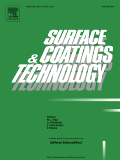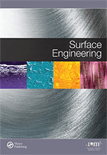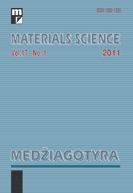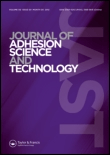
SURFACE & COATINGS TECHNOLOGY
Scope & Guideline
Elevating Knowledge in Surface and Coatings Technology
Introduction
Aims and Scopes
- Surface Engineering Techniques:
Research on various surface engineering techniques such as laser cladding, plasma spraying, and thermal spraying to improve substrate properties. - Material Characterization:
Studies involving the characterization of surface coatings and their impact on mechanical, thermal, and electrochemical properties. - Corrosion Resistance:
Investigation into coatings that enhance corrosion resistance in various environments, particularly for metals and alloys used in biomedical and industrial applications. - Tribological Properties:
Research focusing on the wear and friction performance of coatings under different operational conditions, addressing their behavior in tribological applications. - Biocompatibility and Biomedical Applications:
Exploration of coatings designed for biomedical implants, focusing on biocompatibility, bioactivity, and surface modifications to improve integration with biological tissues. - High-Temperature Performance:
Studies on coatings that maintain their integrity and performance under high-temperature conditions, relevant for aerospace and automotive applications. - Smart and Multifunctional Coatings:
Development of advanced coatings with multifunctional properties, such as self-healing, superhydrophobicity, and antimicrobial effects.
Trending and Emerging
- Advanced Nanostructured Coatings:
Increasing focus on the development of nanostructured coatings that enhance mechanical properties and functional performance, particularly in extreme environments. - Self-Healing and Smart Coatings:
Emerging research into coatings that can autonomously repair themselves or adapt to environmental changes, showcasing a significant trend towards smart materials. - Sustainable and Eco-Friendly Coatings:
Growing interest in environmentally friendly coating processes and materials, reflecting a broader push for sustainability in manufacturing and materials science. - Integration of Machine Learning in Coating Design:
The use of machine learning and computational methods to optimize coating properties and predict performance is becoming increasingly popular. - Multifunctional Coatings for Biomedical Applications:
A noticeable trend towards coatings that offer enhanced biocompatibility and multifunctionality, catering to the needs of advanced biomedical applications. - Coatings for Energy Applications:
Research on coatings specifically designed for energy-related applications, such as fuel cells and batteries, is gaining momentum, focusing on improving efficiency and longevity.
Declining or Waning
- Traditional Coating Methods:
Research on conventional coating methods, such as simple electroplating or basic thermal spray techniques, is becoming less prominent as newer, more advanced methods gain traction. - Single-Function Coatings:
The emphasis on coatings designed solely for one function (e.g., only anti-corrosion) is declining in favor of multifunctional coatings that offer multiple benefits. - Low-Temperature Processes:
Research focused on low-temperature coating processes is waning as high-performance applications increasingly demand coatings that can withstand extreme conditions. - Basic Surface Treatments:
Investigations into basic surface treatments without advanced characterization or innovative applications are decreasing as the field moves towards more complex and integrated solutions.
Similar Journals

China Surface Engineering
Elevating materials science through collaborative insights.China Surface Engineering is a prominent academic journal dedicated to the field of materials science, with a specific emphasis on surfaces, coatings, and films. Published by the Chinese Association of Science and Technology (CAST), this journal serves as an essential platform for researchers, professionals, and students seeking to disseminate knowledge and advancements in surface engineering technologies and innovative applications. With its ISSN 1007-9289 and E-ISSN 1007-9289, it has established a distinct presence since its convergence in 2016, and continues to evolve in the rapidly advancing materials science landscape through to 2024. Although currently categorized in the Q4 quartile of its field, with a Scopus ranking of #103 out of 132 in Surfaces, Coatings and Films, the journal plays a critical role in contributing to the discourse surrounding surface treatment and modification, fostering advancements that are pivotal for industrial applications. As an avenue not only for knowledge transfer but also for collaboration among scientists worldwide, China Surface Engineering is crucial for anyone engaged in research or practical applications in this domain.

Journal of Friction and Wear
Connecting Theory and Application in Material ScienceJournal of Friction and Wear, published by PLEIADES PUBLISHING INC, is a pivotal resource in the field of mechanical engineering, with a particular emphasis on the study of friction, wear mechanisms, and their implications in various materials. With an ISSN of 1068-3666 and an E-ISSN of 1934-9386, this journal provides a platform for cutting-edge research and reviews that contribute significantly to our understanding in these areas. Although currently classified under Q3 in both Mechanics of Materials and Surfaces, Coatings and Films, the journal is making strides towards higher rankings, reflecting its growing influence as it publishes comprehensive analyses and innovative findings. Researchers and professionals can access vital studies, offering insights into improving material durability and performance, integral to numerous industries. This journal serves as a key reference point for students and scholars alike, supporting their quest for knowledge in the evolving landscape of material science.

Journal of Coatings Technology and Research
Elevating Coatings Research for a Sustainable TomorrowThe Journal of Coatings Technology and Research, published by Springer, stands as a vital resource for researchers and professionals in the fields of materials science and chemistry. With an ISSN of 1547-0091 and an E-ISSN of 1935-3804, this journal is recognized for its significant contributions to the study of coatings technology, encompassing diverse aspects from surfaces and interfaces to colloids and surface chemistry. Currently holding a 2023 Impact Factor that places it in the Q2 and Q3 quartiles across several categories—including Chemistry and Colloid and Surface Chemistry—the journal serves as an essential platform for disseminating innovative research. Its accessibility options cater to a broad audience, ensuring that both established scholars and emerging researchers can engage with the latest findings. Since its inception in 2004, the journal has continued to foster advancements in coatings technologies, promoting sustainable practices and novel applications across industries.

Protection of Metals and Physical Chemistry of Surfaces
Exploring the Frontiers of Metal Chemistry and Surface ScienceProtection of Metals and Physical Chemistry of Surfaces is a prominent academic journal published by MAIK NAUKA/INTERPERIODICA/SPRINGER, which provides a specialized platform for researchers and professionals in the fields of materials chemistry, metals and alloys, organic chemistry, as well as surfaces, coatings, and films. With an ISSN of 2070-2051 and an E-ISSN of 2070-206X, the journal is recognized for its rigorous peer-reviewed content and comprehensive coverage of innovative research addressing the latest advancements in material protection and surface chemistry. As of 2023, the journal has been categorized in the Q3 quartile across several relevant fields, highlighting its increasing influence within the scientific community. Although the journal is relatively niche, its open access model encourages wide dissemination of knowledge, fostering collaboration and advancements within its core disciplines. Research published in this journal plays a crucial role in not only enhancing theoretical understanding but also facilitating practical applications in various industries, thereby underlining its importance for students, researchers, and professionals alike.

METALS AND MATERIALS INTERNATIONAL
Driving excellence in materials research since 1996.METALS AND MATERIALS INTERNATIONAL, published by the Korean Institute of Metals and Materials, is a prestigious journal dedicated to the advancement of research in the fields of materials science and engineering. With an ISSN of 1598-9623 and a robust e-ISSN of 2005-4149, this journal has established itself as a crucial platform for disseminating innovative findings and key advancements that span condensed matter physics, materials chemistry, mechanics of materials, and the technology of metals and alloys. Its Q1 rankings in multiple categories attest to its high impact and relevance in the academic community, placing it among the top journals in its fields with Scopus rankings that reflect a strong international footprint. Here, researchers, professionals, and students can access cutting-edge research and insights, fostering collaboration and exploration of new materials and their applications. With a commitment to excellence and a convergence of knowledge from 1996 to 2024, METALS AND MATERIALS INTERNATIONAL continues to enhance our understanding of materials and their transformative impact on technology and engineering.

International Journal of Surface Science and Engineering
Exploring the Frontiers of Surface InnovationThe International Journal of Surface Science and Engineering, published by INDERSCIENCE ENTERPRISES LTD, serves as a vital platform for researchers and professionals in the field of mechanical engineering, surfaces, coatings, and materials science. With an ISSN of 1749-785X and an E-ISSN of 1749-7868, this journal disseminates innovative research addressing the challenges and advancements in surface technologies and engineering practices. Its scope includes, but is not limited to, surface coatings, interface properties, and novel material applications. Since its inception in 2007, the journal has established a solid reputation, achieving a Q3 ranking in Mechanical Engineering and Surfaces, Coatings and Films, and a Q4 ranking in Surfaces and Interfaces as of 2023. These metrics underscore the journal's growing influence, despite being positioned within the Q3 and Q4 quartiles of its categories. The International Journal of Surface Science and Engineering provides a curated collection of high-quality articles that contribute significantly to the understanding of surface phenomena, fostering collaboration and advancements in the field. Researchers, professionals, and students alike will find this journal an indispensable resource for cutting-edge developments and in-depth analyses.

Tribology International
Catalyzing New Ideas in the World of Tribology.Tribology International, published by ELSEVIER SCI LTD, stands as a premier journal in the fields of tribology, mechanical engineering, and material science. With an impressive impact factor and ranking in the Q1 category across multiple disciplines such as Mechanical Engineering and Surfaces, Coatings and Films, this journal serves as a critical resource for researchers, professionals, and students looking to advance their knowledge and application of tribological principles. Established in 1972, Tribology International explores a wide array of topics, including friction, wear, and lubrication, making it indispensable for those dedicated to innovation in engineering and materials sciences. With its rigorous peer-review process and high visibility within the academic community, Tribology International is pivotal in disseminating influential research, fostering new ideas, and shaping the future of tribological research.

SURFACE ENGINEERING
Fostering Collaboration in Material Surface ResearchSURFACE ENGINEERING, published by SAGE Publications Inc, is a premier international journal dedicated to the advancement of knowledge in the fields of material surface science and engineering. With an ISSN of 0267-0844 and E-ISSN 1743-2944, this esteemed journal has been a critical resource since its inception in 1985, and continues to thrive through 2024. Recognized for its impactful contributions, SURFACE ENGINEERING achieves notable rankings in several categories including Q1 in Conservation and Q2 in key areas such as Condensed Matter Physics and Materials Chemistry. The journal serves a diverse audience of researchers, professionals, and students, providing them with insightful research articles, reviews, and technological developments that drive innovation in surface coatings, materials chemistry, and related disciplines. Although the journal follows a traditional subscription model, it remains an essential platform for disseminating crucial findings and fostering collaborations within the scientific community.

Materials Science-Medziagotyra
Unlocking Potential Through Open Access ResearchMaterials Science-Medziagotyra is a prominent peer-reviewed journal dedicated to the field of materials science, published by Kaunas University of Technology in Lithuania. Since its transition to an Open Access model in 2012, it has facilitated broad dissemination of research findings, enhancing accessibility for researchers and professionals worldwide. This journal is indexed in Scopus and has consistently contributed to the academic community with a focus on innovative materials and their applications, ranking in the Q3 category of Materials Science (miscellaneous) as of 2023. With the responsibility of synthesizing substantial research from 2008 through 2024, Materials Science-Medziagotyra aims to bridge gaps in material research while fostering collaboration among scientists, students, and industry leaders. Its commitment to quality and rigor in scientific discourse underscores its relevance and importance in advancing the field.

JOURNAL OF ADHESION SCIENCE AND TECHNOLOGY
Unveiling the Mechanics of Adhesion Technology.Journal of Adhesion Science and Technology is a distinguished publication within the fields of Chemistry, Materials Science, and Engineering, published by the reputable Taylor & Francis Ltd. Since its inception in 1987, the journal has been pivotal in advancing the understanding of adhesion mechanisms, technologies, and applications, boasting a conversion period extending to 2024. With a commendable impact factor and rankings placed in the Q2 category across various relevant domains, including Mechanics of Materials and Materials Chemistry, it offers a robust platform for scholars and practitioners alike. While currently not an open-access journal, it provides multiple access options, ensuring that vital research in adhesion science remains accessible to those dedicated to innovation and practical improvements in material interactions. This journal not only promotes empirical research but also encourages interdisciplinary collaboration, making it essential reading for researchers, industry professionals, and students eager to contribute to this dynamic field.